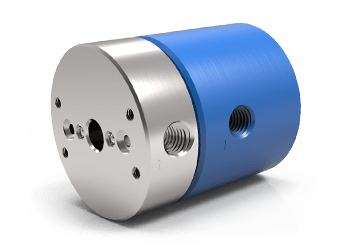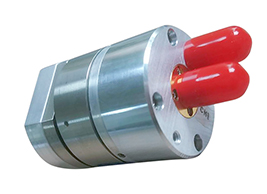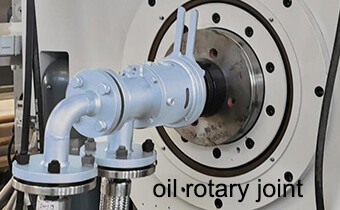Introduction
Coaxial rotary joints continue to be fundamental components in the modern landscape of communications and radar systems. They perform the key task of transmitting radio frequency (RF) signals within rotating systems such as antennas and radar equipment. This translates to enabling seamless signal transmission while ensuring the integrity of signal characteristics and minimal signal loss. Their wide-ranging applications extend across various industries including telecommunications, satellite and radar technologies, and advanced medical equipment.
This comprehensive guide provides an in-depth exploration of coaxial rotary joints, from their fundamental mechanics to their application in real-world scenarios. We also delve into future trends and how technological advancements might influence the development of these key components. The goal is to equip readers with a thorough understanding of coaxial rotary joints and their essential role in the rapidly evolving technological space.
What is a Coaxial Rotary Joint?
Definition of a Coaxial Rotary Joint

A coaxial rotary joint is a precision mechanical device designed to allow for the transmission of radio frequency (RF) signals between stationary and rotating parts within a system. This definition encompasses its crucial attribute: the ability to rotate while preserving the consistent transmission of signals. This is achieved without causing any form of disruption or alteration to the signal’s characteristics, such as its frequency or amplitude. Typically, a coaxial rotary joint would comprise two main parts – an inner conductor that rotates and an outer conductor that remains stationary.
The architectural design of coaxial rotary joints covers a wide frequency range and can handle power at various levels. They are carefully engineered with precise impedance matching to ensure minimal signal loss and reliable electrical performance.
The Purpose and Utilities of a Coaxial Rotary Joint
In terms of utility, coaxial rotary joints play a foundational role in several prevalent technologies in today’s digital age. The primary utility of these joints lies in their capability to facilitate smooth and continuous energy transmission in systems that require parts to rotate relative to each other. Such functionality is critical in a wide range of equipment, including but not limited to, radar antennas, satellite dish antennas, and medical scanning devices.
In the grander scheme of things, the purpose of coaxial rotary joints extends beyond the simple transmission of RF signals. They are integral to maintaining the uninterrupted performance of key operational activities in various sectors like telecommunications, defense, aerospace, and healthcare. From enabling precise weather predictions via satellite-based radar to assuring clear communication lines in defense applications, they bolster countless elements of modern infrastructure.
So, despite their relatively compact size, the role of coaxial rotary joints is monumentally significant to the functioning of an array of high-tech systems. They represent a small yet critical cog within these larger technological wheels, ensuring their continual smooth operation.
Coaxial Rotary Joint: Core Mechanics
Layout and Design
Integral to the function of a coaxial rotary joint is its design, dictating its critical ability to allow for unrestricted rotation while preserving signal transmission. Each coaxial rotary joint typically consists of a rotating inner conductor surrounded by a stationary outer conductor. Precision bearings are used to facilitate the smooth rotation of the inner conductor while minimizing axial or radial play.
Furthermore, the design is intended to endure a predefined number of rotations and meet stringent performance parameters like insertion loss, voltage standing wave ratio (VSWR), and phase and amplitude stability. The design elements of a coaxial rotary joint must be meticulously executed to ensure high electrical and mechanical performances across an array of frequencies and varying environmental conditions.
The Role of Each Fundamental Component
Every component of a coaxial rotary joint plays its part in ensuring efficient signal transmission between stationary and rotating parts. The rotating inner conductor and stationary outer conductor form the primary pathway for signal transmission. Separating these conductors is a dielectric material that ensures electrical isolation between them.
Precision bearings are used to provide support, allowing for the free rotation of the inner conductor while preventing excessive axial and radial play. Electrical contacts are employed to ensure seamless transmission of signals from the stationary components to the rotating inner conductor, making them an essential part of the joint’s construction.
Understanding the Principles of Coaxial Rotary Joints Operation
Operating a coaxial rotary joint applies a simple yet powerful principle. It aims to maintain a continuous connection that allows for a seamless transfer of energy between stationary and rotating components. This entails precision in design and construction to ensure repeated and uninterrupted rotations without degrading the signal transmission quality.
Electrical contacts and precision bearings achieve this feat, coupling mechanically engaging parts while maintaining electrical continuity. The joint’s design mitigates insertion loss and maintains stable VSWR over its specified frequency range to provide consistent performance.
In essence, a coaxial rotary joint relies on the harmonious synchronization of mechanics and electronics to ensure efficient signal transmission between stationary and rotating systems under varying conditions.
Coaxial Rotary Joint: Varieties
Categorization by Frequency Ranges (RF, Microwave, Millimeter Wave)
Coaxial rotary joints are designed to operate across different frequency ranges, tailoring them to specific applications. Based on these ranges, they can be classified into:
- RF rotary joints These joints typically handle frequencies ranging from hundreds of kHz to hundreds of MHz. They are commonly used in applications like broadcasting, communication systems, and radar systems.
- Microwave rotary joints: Operating within the GHz range, these joints find use in applications like satellite communications, precision radar systems, and navigation systems.
- Millimeter wave rotary joints: Handling frequencies from tens to hundreds of GHz, these joints are employed in advanced applications such as high-speed wireless communication systems, high-resolution radar systems, and radio astronomy.

Categorization by Channels (Single-channel and Multi-channel)
Depending on the number of separate signal pathways that a coaxial rotary joint incorporates, it can be categorized into:
- Single-channel rotary joints: Designed to transmit a single RF signal at a time, these rotary joints are suited for systems requiring uncomplicated signal transmission. They’re often used in satellite communication systems, radar systems, and medical imaging devices.
- Multi-channel rotary joints: Facilitating the simultaneous transmission of multiple RF signals, these more complex joints are applicable in advanced communication systems that require the transfer of multiple signals through a single device. They provide increased performance and efficiency in applications such as air traffic control, military communications, and sophisticated radar systems.
To learn more about the differences between RF rotary joints, single-channel, and multi-channel, you can read RF Rotary Joints: Single-Channel Vs. Dual-Channel.
Categorization by Materials
Coaxial rotary joints can also be classified according to the materials used in their construction, which directly impact their performance, longevity, and resistance to environmental factors:
- Brass rotary joints: Brass provides a cost-effective, durable, and corrosion-resistant solution suitable for a variety of applications. These joints tend to be applicable where a balance between performance and cost is essential.
- Stainless steel rotary joints: Offering high strength, durability, and excellent corrosion resistance, stainless steel joints are ideal for demanding applications or hostile environments. They are commonly utilized in military, aerospace, and high-performance communication systems.
- Aluminum rotary joints: Lighter and more cost-effective than stainless steel, aluminum rotary joints are suitable for applications where weight reduction is crucial. Satellite communication systems, for example, often employ these joints.
These categories exemplify the diverse nature of coaxial rotary joints, which can be tailored to meet the unique requirements of their respective applications, frequency ranges, and operational environments.
Coaxial Rotary Joint: How to Select
To ensure optimal performance and longevity of a coaxial rotary joint in a given application, selection must be done carefully. This entails making a choice based on several factors, understanding specification sheets, and considering the operational environment’s impact.
Selecting the Right Rotary Joint: Factors to Consider
Senior design engineers and purchasers alike must take into account several factors when selecting a coaxial rotary joint:
- Frequency range: The joint’s frequency range should align with the system’s operational frequency. This will help to mitigate potential issues with signal loss or distortion.
- Number of channels: The number of RF signals the system needs to simultaneously handle will determine whether a single-channel or multi-channel rotary joint should be selected.
- Material of construction: Different materials offer varying degrees of durability, corrosion resistance, and weight. This balance of factors should match the overall joint’s intended lifespan and application conditions.
- Size and weight: Depending on the system’s physical constraints, the size and weight of the rotary joint may be a crucial selection factor.
Understanding Specification Sheets
Specification sheets provide a comprehensive overview of a product’s technical attributes. For coaxial rotary joints, these generally include:
- Frequency range: The range of frequencies the joint is designed to handle.
- Insertion Loss: The signal strength loss when a signal passes through the joint.
- VSWR (Voltage Standing Wave Ratio): A measure of how efficiently RF power is being transmitted and reflected within the joint.
- Isolation: The extent to which the joint prevents signal leakage between input and output.
Specifications sheets aid decision-makers by consolidating the essential information required to compare and contrast different products.
The Impact of Operating Environment on Coaxial Rotary Joint Performance
The performance and longevity of a coaxial rotary joint can be significantly impacted by its operating environment. Therefore, it’s crucial to consider:
- Temperature: Extreme temperatures may cause material expansion or contraction and potentially impair the rotary joint’s performance.
- Humidity: Exposure to moisture can lead to material corrosion, impacting the joint’s lifespan and efficiency.
- Pressure: High or low-pressure environments may influence the joint’s functioning, especially concerning the seals and bearings.
By taking these aspects into account, one can select a coaxial rotary joint that is best suited to managing the inherent challenges of its operational environment. This careful selection yields optimal performance and a longer service lifespan.
Coaxial Rotary Joint: Installation and Maintenance
The proper performance of coaxial rotary joints is contingent not only on the correct choice of product but also on proper installation and diligent maintenance practices. Therefore, it is equally essential to understand installation procedures, testing protocols, and maintenance tips to ensure optimal performance throughout the lifespan of the joint.
Proper Installation Practices for Coaxial Rotary Joints
Proper installation of a coaxial rotary joint is crucial to its functionality and performance. Some best practices for installation include:
- Pre-Installation Check: Prior to installation, it is necessary to inspect the joint for any visible damage or defects that may have occurred during transit.
- Following Manufacturer Guidelines: Adhere strictly to the manufacturer’s guidelines for installing the rotary joint.
- Correct positioning: Position the rotary joint properly to ensure it aligns with the path of the coaxial cables and the connected systems to minimize strain on the joint.
- Secure Connection: Ensure all connections are secure and tight. Loose connections could impede signal transmission.
- Environment check: Confirm that the joint’s installation location aligns with its specified operating conditions, such as temperature, pressure, and humidity.
An In-depth Look at Testing Protocols
Testing protocols vary based on the specific application and type of coaxial rotary joint. However, a few common tests are generally incorporated to ensure high performance:
- Frequency Test: This verifies the joint’s ability to transmit signals effectively across its specified frequency range.
- Insertion Loss Test: This determines the joint’s impact on reducing signal strength as the signal is transferred through the joint.
- VSWR Test: This test verifies the efficiency of signal transmission and reflection in the joint.
- Isolation Test: This assesses the joint’s capacity to prevent signal leakage between input and output.
- Durability and Longevity Tests: These tests are used to evaluate the rotary joint’s performance under prolonged usage or adverse conditions.
Effective Maintenance and Troubleshooting Tips
Regular maintenance of the coaxial rotary joint is needed for its long-term and efficient operation. Some tips for maintenance and troubleshooting include:
- Regular inspections: Regularly inspect the rotary joint for any visible damage, loose connections, or signs of wear and tear.
- Cleaning: Routinely clean the joint to remove dust or any other contaminants that may affect its performance.
- Lubrication: Apply suitable lubricant, as per the manufacturer’s recommendation, to minimize wear and ensure smooth rotation.
- Regular Performance Checks: Conduct frequent performance checks according to the manufacturer’s guidelines to ensure the joint’s optimal operation.
- Professional Maintenance and Repairs: In case of severe issues, it is always recommended to approach a professional for maintenance or repair to avoid any potential damage.
Following the above guidelines and recommendations for installation, testing, and maintenance practices will help ensure the extended lifespan and enhanced performance of the coaxial rotary joints.
Coaxial Rotary Joint: Case Studies
Coaxial rotary joints play a pivotal role in many real-world applications and industry-specific uses. Through effective implementation, they contribute significantly towards the efficiency of systems where they are utilized. Let’s investigate some case studies of coaxial rotary joint utilization.
Real-World Applications of Coaxial Rotary Joints
Understanding the role of coaxial rotary joints in real-world applications can shed light on their effectiveness and versatility. Here are a couple of instances:
Satellite Communication Systems: In satellite dishes, coaxial rotary joints enable the continuous rotation of the dish while maintaining reliable data transmission. This plays a pivotal role in flight tracking and weather observation satellites where constant contact is imperative.
Radar Systems: Radar systems, both in civilian air traffic control and military applications, require fast, precise, and uninterrupted signal transmission. Coaxial rotary joints allow the radar antennas to rotate continuously, ensuring 360° coverage.

Medical Imaging Devices: Rotary joints are used in CT scanners and MRI systems where they facilitate the movement of the imaging device around the patient while maintaining high-quality signal transmission for accurate imaging.

Industry-Specific Uses and Highlights
Examining industry-specific uses of coaxial rotary joints can provide a clearer picture of their diverse applications:
- Aerospace Industry: Space systems like satellites and space station communication systems employ coaxial rotary joints for their high reliability and capacity to handle multiple RF signals at varying frequencies. Their robust construction also enables them to endure harsh space conditions.
- Defense Industry: Coaxial rotary joints are integral to advanced military communication systems and radars. Specifically tailored for these applications, these joints offer high durability, multi-channel capabilities, and resistance to harsh environmental conditions.
- Medical Industry: In the medical field, these rotary joints facilitate precise signal transmission crucial for high-quality imaging in diagnostic equipment like MRI and CT scanners. Their reliability ensures accurate diagnostics and patient well-being.
In these case studies, each industry leverages the unique capabilities of coaxial rotary joints. This showcases the rotary joint’s ability to meet diverse operational demands, standing testament to their adaptability, efficiency, and importance across multiple sectors.
Coaxial Rotary Joint: Future Trends and Developments
Understanding the potential future trends and technological advances can provide insights into the direction that coaxial rotary joint designs might take. With the evolving technological landscape and rising demand for higher efficiency and reliability, the future might hold several exciting developments for coaxial rotary joints.
The Future of Coaxial Rotary Joints: Predicted Trends
As the need for high-speed, reliable communications and advanced imaging technologies rises across various sectors, the future of coaxial rotary joints may see several notable trends:
- Increased Frequency Capabilities: There may be a push towards rotary joints capable of handling higher frequency ranges to support the escalation in data transmission demands.
- Multi-Channel Evolution: As systems become more complex, the demand for rotary joints that can handle numerous channels simultaneously without signal interference or leakage may grow.
- Miniaturization: Given the trend towards more streamlined and compact devices, rotary joints may also need to become more space-efficient, meaning reduced size without compromising performance and durability.
- Material Innovation: Future developments may also focus on innovative materials or coatings that enhance the longevity and reliability of rotary joints while resisting environmental challenges.
How Technological Advancements Could Impact Future Coaxial Rotary Joint Designs
Technological progress has a significant role in driving design changes across all fields, and coaxial rotary joints are no exception. Consider these ways in which advancements could shape future designs:
- AI and Machine Learning: Machine learning algorithms could be employed for predictive maintenance, working to identify potential issues with the rotary joint before they become problematic.
- Advanced Manufacturing Techniques: Techniques such as additive manufacturing (3D printing) could allow for flexible and innovative rotary joint designs while reducing production costs and times.
- Improvement in Seals and Bearings: Advancements in materials science may lead to more robust seals and bearings that extend the operational lifespan of rotary joints and withstand adverse conditions.
- Integration with IoT: The incorporation of IoT capabilities could lead to smarter rotary joint systems able to communicate data about their performance, enhancing efficiency and mitigating problems in real time.
By anticipating these trends and advancements, we can look forward to a future where coaxial rotary joints deliver even more outstanding performance within an increasingly interconnected technological landscape.
Conclusion
In this comprehensive guide, we have explored various aspects of coaxial rotary joints, delving into their integral role in a multitude of industries and applications. As we wrap up, let us briefly recap the critical points we’ve covered:
- Fundamentals of Coaxial Rotary Joints: These are specialized devices designed to transmit electrical signals (RF/microwave) across a rotating interface while maintaining high performance and minimal loss.
- Selection Criteria and Factors: Understanding factors such as frequency range, power handling, insertion loss, VSWR, and operating conditions is crucial in making an informed choice for your specific application.
- Installation and Maintenance: Proper installation, testing, and maintenance practices can significantly increase the efficiency and longevity of coaxial rotary joints.
- Case Studies: Examining various real-world applications and industry-specific uses highlights the essential role of coaxial rotary joints in modern technology.
- Future Trends and Developments: Technological advancements and evolving market trends will likely lead to more efficient, high-performance, and compact rotary joint designs in the coming years.
Encouragement for Further Learning and Exploration
Having reviewed the core aspects of coaxial rotary joints, we encourage you to delve deeper into their applications, designs, and technological innovations shaping their future. Expanding your understanding will enable you to make well-informed decisions and refine your skills in selecting, installing, and maintaining these devices. Staying abreast of the latest research and industry trends will help ensure that you can harness the full potential of coaxial rotary joints and adapt to the ever-changing landscape of technology.
FAQ about Coaxial RotaryJoint
To further deepen your understanding, here are answers to some commonly asked questions about coaxial rotary joints:
Q: Where are coaxial rotary joints used?
A: Coaxial rotary joints are used in various industries and applications, including satellite communication systems, radar systems, medical imaging devices like CT scanners, and in the aerospace and defense industries. They facilitate continuous, reliable signal transmission for these systems and devices.
Q: What factors should I consider when selecting a coaxial rotary joint?
A: When selecting a coaxial rotary joint, consider elements such as operating frequency range, power handling capacity, insertion loss, Voltage Standing Wave Ratio (VSWR), isolation, and phase, and amplitude stability, among others. These factors will help ensure optimal performance and lifespan of the rotary joint within your specific application or system.
Q: How should I install and maintain my coaxial rotary joint?
A: Proper installation and maintenance are key to the longevity of a coaxial rotary joint. These practices include a pre-installation inspection, following the manufacturer’s installation guidelines, positioning the joint correctly, ensuring tight connections, and checking environmental conditions during installation. Regular maintenance should involve inspections, cleaning, lubricating (if necessary), consistency in performance checks, and professional repairs in case of severe issues.
Q: What technological advancements are expected in coaxial rotary joints?
A: Future trends for coaxial rotary joints may include increased frequency capabilities, multi-channel evolution, miniaturization, and material innovations. Technological advancements could incorporate the use of AI and machine learning for predictive maintenance, advanced manufacturing techniques like 3D printing, development in materials science for better seals and bearings, and integration with IoT for real-time performance data and issue mitigation.
By understanding these fundamental aspects of coaxial rotary joints, you can better appreciate their role and capabilities in a multitude of applications and sectors.
See What We Can Do

